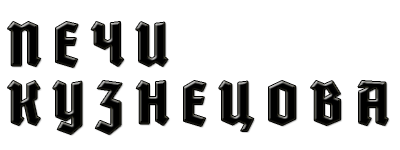620143 Ekaterinburg
Pobedy Street 51 - 87
Testing with infrared imager
TESTING OF THE HEAT DISTRIBUTION PATTERN IN “DOUBLE-BELL” STOVES WITH INFRARED IMAGER . By I. V. Kuznetsov A possibility for such testing has arisen after a meeting with director of a regional program on energy saving, professor N. I. Danilov. Hi is the head of Secretariat of Governor of the Region, and the head of the “Energy Saving and Conservation” Department of the Ural State Technical University. At one of the Deparetment's meetings, hi has shown interest in testing some of our stoves and woodburning boilers. Head of the Energy Efficiency Department of the State's energy controlling organization, “GOSENERGONADZOR”, A. M. Klukin, kindly agreed to test the heat distribution pattern in our stoves with an infrared imager. The testing took place on February 24, 2004 and has been done by engineer V.S. Koshman (phone: 7 (343) 3776923) with my participation. No special preparation has been done before testing. We just arrived to the Monastery and selected one stove (1) in “Derzhavnyj” temple (2). There was no service at the temple at the time. (I have wrote about the Monastery in my articles before. All the buildings there are heated by our stoves).
The stove's total volume of the chambers is equal to 10 м3. It is faced over the brick laid in clay mortar with ceramic cachels. The cachels have a special shape with a cavity inside. Because some of the cachel's cavities might not be completely filled with the mortar, we decided to take measurements at the joints. We couldn't fit the total surface of the stove on one image, so we had to take two and combine them. (4 and 5).
Slight discrepancy of the temperature measurements at the same spots is the result of variations appearing during the data processing. Image (5) shows that the stove's lower part is heated better than the upper one. You can see that temperatures are lower at the upper right corner above the damper. There is a special smoke chamber. Its creation was necessary to shift the chimney into the right location. Image (4) shows that the left side is heated 5-12 degrees lower than the right one. It is explained by the stove's location. There is a doorway from this side, so room drafts cool the stove's surface here. Temperature of the firebox door is 82.8 degrees.
age (6) show stove's side. Here again, the lower part is heated better, therefore heat output of the lower “bell” is higher than of one of the upper part. The far right side of the lower “bell” has lower temperature. Here, an “updraft” channel is located. This is the channel which takes the exhaust gases from the lower “bell” into the upper “bell”. The lower temperature of the channel's walls proves high heat retention capability of the “bell”. It has to be noted that insulating material filling the gaps around the windows and between the logs in the walls is very badly packed. You can see it on the images (7) and (8). Temperature at some spots is 3 degrees only! Even under these conditions an average walls' temperature at 7 feet above the floor is 17 degrees Celsius. Therefore, the stoves provide necessary amount of heat to maintain required temperature in the temple.
After testing this stove, we took an image (9) of a brick steam sauna stove at the same Monastery. It is interesting that clay mortar joints are heated about 20 degrees higher than bricks, and the stove's corners are heated 20-30 degrees lower.
|









